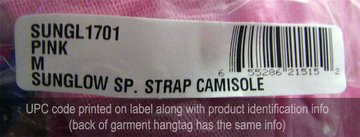Oh so long ago, I wrote this rant discussing my issues with product identification for apparel. Kathleen suggested that I show some examples of different types of product identification, so I am. Originally, my product identification post was supposed to be a prelude to discussing order fulfillment, but now I see that there are so many things that need to come before that.
I have captioned the pictures but I don’t know that the captions will be visible on all monitors so I’ve included the information underneath as well. Here are a range of different kinds of product identification labels and hang tags. You’ll notice that some labels with UPC codes are from companies that sell to department stores. Now most of you won’t sell to department stores, but some of you will want to sell to larger independent retailers who prefer bar codes. Since it costs money to obtain a membership to the UCC to be able to issue UPC Codes (and starts at hundreds of dollars per year), I will give you a tip -the one universal format for bar coding (often used in warehousing and distribution) is UCC 39 and most bar code scanners and POS systems can read that format. You can buy the bar code fonts over the web if your computer software doesn’t already have it.
Having said that, here are various types of product identification labels. These are important because on the receiving end, it helps retailers (and customers) identify your products. I feel strongly that your products should be properly identified in such a way that someone who is not familiar with your line can pull and pack an order based on the information on a packing slip. Someone on the receiving end -who is similarly unfamiliar with your products- can match each item with the packing slip. This really cuts down on errors.
To recap, here are the things I think should be included in your product identification (and when I say packaging label, I mean the label that is on the plastic bag your products are stored in):
* Company/Brand Name (hang tags)
* Product style number (hang tags and packaging labels)
* Product style name (hang tags and packaging labels)
* Color (hang tags and packaging labels)
* Size (hang tags and packaging labels)

Handwritten product info on the back of hang tag allows a retailer the room to write the price

Product tag with product information and UPC bar code

UPC bar code printed on label along with product identification information. The back of garment hang tag has the same information.

Product identification label applied to back of hang tag. The same label is used on plastic packaging.

UPC code and product identification on label on product plastic wrapping. The hang tag is shown in the picture previous to this one

This is a really simple one, with product code and size stamped on the back of the hang tag

Avery label 5160 printed on a computer (nearly anyone can do this)
In addition to reading my first post, you should also reacquaint yourself with the laws of labeling (read this post too) because you can get into trouble. Just as food products must contain accurate nutritional contents, so must your products. For example, you are only supposed to use “Made in USA” when your product and fabric are made in the US, otherwise you would use “Made in the USA of imported fabric” (or whatever is applicable). The reason I bring this up is because I have seen companies use “Made in USA” when they are using imported fabric.
Related:
Selling to department stores pt.1

Freight and warehouse chargebacks
Chargebacks are a fine or penalty that a retailer will levy against the vendor (you). If you are assessed a chargeback, the fee is deducted from what they owe you on the invoice. Chargebacks can be assessed for reasons such…